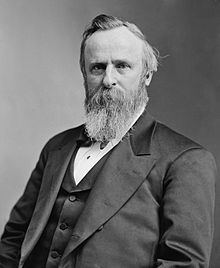 | |
| Presidency of Rutherford B. Hayes March 4, 1877 – March 4, 1881 | |
| Cabinet | See list |
|---|---|
| Party | Republican |
| Election | 1876 |
| Seat | White House |
|
| |
| Library website | |
| ||
|---|---|---|
|
29th and 32nd Governor of Ohio
19th President of the United States
Presidential campaigns
Post-presidency
|
||
The presidency of Rutherford B. Hayes began on March 4, 1877, when Rutherford B. Hayes was inaugurated as President of the United States, and ended on March 4, 1881. Hayes became the 19th president, after being awarded the closely contested 1876 presidential election by Republicans in Congress who agreed to the Compromise of 1877. That Compromise promised to pull federal troops out of the South, thus ending Reconstruction. He refused to seek re-election and was succeeded by James A. Garfield, a fellow Republican and ally.
In general, Hayes was a moderate and a pragmatist. He kept the promise to withdraw the last federal troops from the South, as Democrats took control of the last three Republican states. A paragon of honesty, he sponsored civil service reform, where he challenged the patronage hungry Republican politicians. Though he failed to enact long-term reform, he helped generate public support for the eventual passage of the Pendleton Civil Service Reform Act in 1883. The Republican Party in the South grew steadily weaker as his efforts to support the civil rights of blacks in the South were largely stymied by Democrats in Congress.
Insisting that maintenance of the gold standard was essential to economic recovery, he opposed Greenbacks (paper money not backed by gold or silver) and vetoed the Bland–Allison Act that called for more silver in the money supply. Congress overrode his veto, but Hayes's monetary policy forged a compromise between inflationists and advocates of hard money. He used federal troops cautiously to avoid violence in the Great Railroad Strike of 1877, one of the largest labor strikes in U.S. history. It marked the end of the economic depression called the "Panic of 1873". Prosperity marked the rest of his term. His policy toward Native Americans emphasized minimizing fraud. He continued Grant's "peace plan" and anticipated the assimilationist program of the Dawes Act of 1887. In foreign policy, he was a moderate who took few initiatives. He unsuccessfully opposed the De Lesseps plan for building a Panama Canal, which he thought should be an American only program, Hayes asserted U.S. influence in Latin America and the continuing primacy of the Monroe Doctrine. Polls of historians and political scientists generally rank Hayes as an average president.


